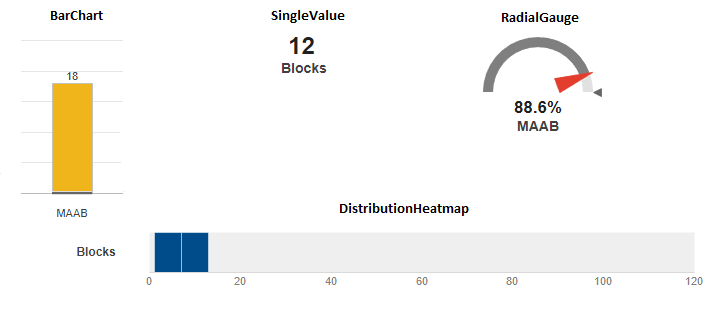slmetric.dashboard.CustomWidget Class
Namespace: slmetric.dashboard
(To be removed) Object for holding custom Metrics Dashboard widgets
The Metrics Dashboard user interface, metricdashboard function, slmetric package API, and corresponding customizations will be removed in a future release. For more information, see Migrating from Metrics Dashboard to Model Maintainability Dashboard.
Description
For custom or shipped metrics, use the slmetric.dashboard.CustomWidget
object to visualize metric data in the Metrics Dashboard. Choose a single value, radial gauge,
bar chart, or distribution heat map approach.
Construction
For slmetric.dashboard.Layout,
slmetric.dashboard.Container, or
slmetric.dashboard.Group objects, use the addWidget or
removeWidget methods to add or remove
slmetric.dashboard.CustomWidget objects from the Metrics
Dashboard.
The Metrics Dashboard layout is divided into 12 columns of equal size. Use
slmetric.dashboard.CustomWidget methods to specify the widget
size.
To specify the metric data that the widget displays, use the method
setMetricIDs to assign metric IDs to the widget. The custom widget
automatically scales to fit the number of metrics IDs that you specify. For example, if you
create a custom bar chart widget and specify two metric IDs, the bar chart widget uses two
bars in the bar chart to display the metric results.
Properties
Methods
| getHeight | (To be removed) Obtain height of Metrics Dashboard custom widget |
| getMetricIDs | (To be removed) Obtain metric identifier for custom Metrics Dashboard widget |
| getPosition | (To be removed) Obtain custom widget position within Metrics Dashboard |
| getSeparators | (To be removed) Determine whether there are lines on sides of Metrics Dashboard custom widget |
| getWidths | (To be removed) Obtain widths of Metrics Dashboard custom widget |
| setHeight | (To be removed) Specify height of Metrics Dashboard custom widget |
| setMetricIDs | (To be removed) Set metric identifier for custom Metrics Dashboard widget |
| setPosition | (To be removed) Set custom widget position within Metrics Dashboard |
| setSeparators | (To be removed) Specify lines on Metrics Dashboard custom widget sides |
| setWidths | (To be removed) Specify multiples widths for Metrics Dashboard custom widget |
